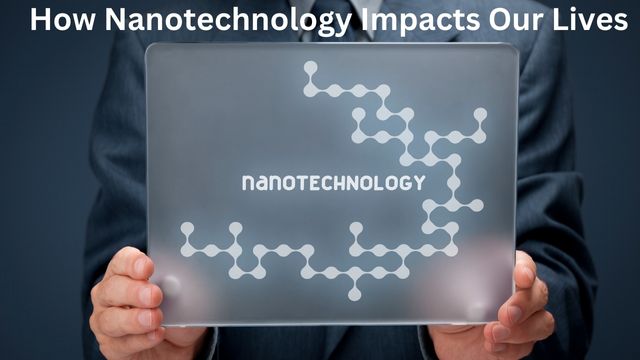How Nanotechnology Impacts Our Lives

How Nanotechnology impacts our Lives: Although the term “nanotechnology” is widely used these days, many of us are unaware of the incredible influence it has on our daily lives. Nanotechnology is “science, engineering, and technology undertaken at the nanoscale, which is approximately 1 to 100 nanometers,” according to the United States National Nanotechnology Initiative. One nanometer, or 10-9 of a meter, is one billionth of a meter.
A sheet of paper is roughly 100,000 nanometers thick as a point of comparison. At the nanoscale, scientists are learning how atoms and molecules act differently.
Additionally, the field is increasing quickly. Making materials at the nanoscale, which have advantages over their larger-scale counterparts in terms of improved qualities including stronger strength, lighter weight, increased electrical conductivity, and chemical reactivity is proving to be very successful for scientists and engineers.
Here are the daily effects of nanotechnology on our lives.
Nanotechnology Impacts
- Computers that are faster, more compact, and more powerful, use much less energy and have batteries that last longer.
- Carbon nanotube-based circuits may be essential for sustaining Moore’s Law and the increase in computing power.
- Quicker, more useful, and more precise medical diagnostic tools.
- Point-of-care testing in real-time is made possible by lab-on-a-chip technology, hastening the delivery of medical care.
- Implant surfaces made of nanomaterials are more durable and infection-resistant.
- Pharmaceutical items, frequently delivered through a combination of medical devices, benefit from nanoparticles that increase their absorption inside the body and facilitate delivery.
- Additionally, chemotherapeutic medications can be delivered by nanoparticles to particular cells, such as cancer cells.
- By using nanocomposite materials to create car parts that are stronger, lighter, and more chemically resistant than metal, it is possible to increase the fuel efficiency of vehicles and their corrosion resistance.
- To further increase gas mileage, nanofillers almost eliminate all airborne particles from the air before it enters the combustion chamber.
- Nanoparticles or nanofibers can improve a fabric’s stain, water, and flame resistance without significantly adding to its weight, thickness, or stiffness. For instance, pants with “nano-whiskers” are water- and stain-resistant.
- Virtually all viruses and bacteria can be removed using water filters that are barely 15–20 nanometers broad.
- These portable, cost-effective water treatment systems are perfect for raising the standard of drinking water in developing nations.
- Carbon nanotubes can be used to strengthen and lighten sporting equipment, among other commercial applications. For instance, a carbon nanotube-enhanced tennis racket boosts the force and accuracy of the delivery by bending less under impact.
- Tennis balls coated with nanoparticles can bounce twice as long as untreated tennis balls.
- The majority of sunscreens on the market now contain nanoparticles, which efficiently absorb light, including the more hazardous UV spectrum.
- They also spread throughout the skin more readily. To lessen UV exposure and increase shelf life, the same nanoparticles are also utilized in food packaging.
- To boost resistance to absorption by oxygen, carbon dioxide, and moisture, many drink bottles are composed of plastics containing nanoclays.
- This extends shelf life by several months and aids in maintaining pressure and carbonation.
- Nanotechnology has made it possible to program a wide range of chemical sensors to identify a specific chemical at incredibly low levels, such as one molecule out of billions.
- Systems for monitoring and security at labs, business locations, and airports can benefit greatly from this capacity.
- Nanosensors can be used in medicine to precisely identify specific cells or chemicals in the body.
On the Horizon
These are only a handful of the countless effects of nanotechnology on society. There appear to be significant nanotechnology accomplishments announced virtually every day. As an illustration, scientists at George Washington University have found a mechanism to capture carbon dioxide from the environment and transform it into high-yield carbon nanofibers that may be applied in manufacturing.
According to chemistry professor Stuart Licht, who oversaw the study team, “Such nanofibers are utilized to manufacture strong carbon composites, such as those used in the Boeing Dreamliner, as well as in high-end sports equipment, wind turbine blades, and a plethora of other items.”
A hybrid system made up of solar cells and a thermal energy collector that uses relatively little energy powers the process. According to Licht, the method would bring atmospheric carbon dioxide to pre-industrial levels in ten years if it were scaled up to a size that was less than 10% of the size of the Sahara Desert.
The cleaning of air and water, according to Markus Antonietti, head of the Max Planck Institute of Colloids and Interfaces at the Max Planck Institute for Evolutionary Biology, is where nanotechnology has the most potential to make the world a better place.
He claims the technology to improve the atmosphere is already available. “However, there also needs to be a focus on education and informing the general public. The majority of people are still unaware of these technologies.
The best part is that if we merely disseminate the knowledge understandably, all of this might happen right away. People don’t even realize that all of this is feasible since they don’t read scientific papers.
Is nanotechnology safe?
The use of nanotechnology has enormous potential to improve people’s lives. As we begin to utilize affordable, lightweight solar polymers, solar energy will become widely accessible.
Both airborne contaminants and dangerous chemical spills can be cleaned up using nanoparticles. Nanomaterials, according to experts, may be utilized in space exploration.
Despite these benefits, there is a dark side to nanotechnology. We do not yet fully understand the long-term ramifications of this science’s ability to affect the release of nanoparticles into the environment. Nanotechnology is currently unregulated.
Companies are not even required to name their nanoparticle-containing products. In reality, there are no accepted guidelines for creating and using nanomaterials.
Concerns regarding the possible impact of nanoparticles on our health, the environment, and ecosystems are widespread. According to several research, some nanomaterials are highly harmful to fish, invertebrates, and algae. Nanomaterials can even be passed down over multiple generations in plants and animals.
How is nanotechnology used in everyday life?
What are the impacts of nanotechnology on humans as the economy?
How will nanotechnology change the world?
What are the benefits of nanotechnology?
Conclusion
“Nanotechnology” is defined as “science, engineering, and technology applied at the nanoscale,” or between one and one hundred nanometers. A sheet of paper is roughly 100,000 nanometers thick, or 10-9 of a meter, which is one billionth of a meter. Medical professionals can utilize nanosensors to precisely detect particular cells or molecules in the body.
Tennis balls with carbon nanotube enhancement can bounce twice as far as balls without the technology. Numerous beverage bottles are made with nanoclays-containing polymers, which prolong shelf life by several months.
Researchers have developed a method to convert atmospheric carbon dioxide into high-yield carbon nanofibers that may be used in manufacturing. The development of nanotechnology has the potential to boost economic growth, and improve industrial sector capacity and quality.








🙏 🙏 ❤ ❤ Always be updated with computer tips, mobile tips, how to fix, tech reviews, and tech news on Rowdytech, or subscribe to the YouTube channel.